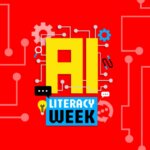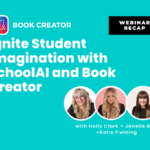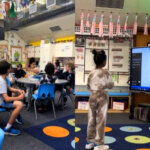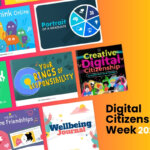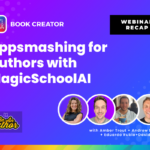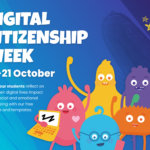We promised a week of practical, classroom-ready ideas for teaching with AI—and we’re delivering. Below is a single recap that stitches together our first two sessions: Common Sense Education’s Jennifer Ehehalt and Dr. An Wren, and Alana Winnick with her Students for Innovation. Hosting the series are David Hotler and Katie Fielding from Book Creator.
Grab all slides, templates, and examples in one place →
Common Sense Education: Building AI Literacy That Sticks
Guests: Jennifer Ehehalt, Dr. An Wren | Hosts: David Hotler
Jennifer Ehehalt and Dr. Anne Wren reminded us early on that AI literacy is about far more than just tools. It’s about helping students understand how AI works, what it’s good at, where it falls short, and how to use it ethically. Issues like bias, misinformation, privacy, and proper attribution need to be part of everyday classroom conversations—not side notes.
They shared practical ways to bring this to life through digital citizenship moments. Instead of treating AI outputs as answers, students should be coached to ask probing questions: Where did this information come from? What might be missing? Could it be biased? These moments build the habits of critical thinking that students need to navigate an AI-driven world.
The speakers also stressed the importance of establishing clear classroom norms. Students feel more confident when expectations are explicit—what kinds of AI use are allowed, what’s encouraged, what’s off-limits, and how to properly acknowledge AI assistance. With examples in hand, teachers can turn uncertainty into transparency.
Equally important is family communication. By sharing the “why” behind classroom policies, showing parents examples of constructive AI use, and opening up space for questions, schools can turn families into partners rather than skeptics.
Finally, Jennifer and Anne noted that AI has potential as a set of time-savers for teachers—but only if used wisely. From drafting rubrics to creating lesson hooks, adjusting reading levels, or generating exemplar responses, AI can lighten the load. But the speakers were clear: teachers must still design for thinking, not outsourcing. AI should give time back to deepen instruction, not replace it.
Try this: Use our one-page AI Use Policy + Student Agreement template to set norms in minutes.
Alana Winnick & Students for Innovation: Redefining Learning with AI
Guest: Alana Winnick | Student Guests: Students for Innovation | Hosts: David Hotler
One of Alana’s strongest messages was that educators don’t need to have all the answers before bringing AI into the classroom. Instead, she encouraged teachers to embrace a sense of comfort in discomfort. Rather than positioning themselves as the ultimate experts, teachers can model curiosity and learn alongside their students—a move that aligns closely with the ISTE Standards for Educators.
She also challenged educators to put every assignment through what she calls the “What–Why–How” test. Ask yourself: What are students being asked to do? Why are they doing it—what authentic purpose or audience does the task serve? And how are you assessing the learning? This shift pushes assignments beyond surface-level outputs to meaningful demonstrations of knowledge and skill.
A practical way to apply this is through the AI-able check. If a large language model can generate the same response in seconds, then the task needs to be reframed. Instead of worksheets or essays that AI can complete instantly, teachers should design for originality, creativity, and real-world audiences.
Throughout her session, Alana emphasized a mindset of focusing on process over product. The quality of student drafts, revision notes, feedback cycles, and media choices can often reveal more about their growth than the polished final submission. By valuing these steps, teachers give students credit for their learning journey, not just their endpoint.
Finally, she encouraged educators to eliminate redundancy and reclaim time. Once students have mastered a basic skill, there’s no need to keep assigning repetitive work. With AI as a support, teachers can streamline the routine tasks and free up space for projects that stretch creativity, critical thinking, and collaboration.
From Essays to Impact
Alana’s students showed just how powerful a shift in assignment design can be. Instead of stopping at a traditional persuasive essay, they transformed their arguments into TED-style talks. With AI acting as a brainstorming partner and speaking coach—suggesting phrasing, refining outlines, and even generating supportive visuals—students gained the confidence to present in front of live audiences made up of parents and community members. The result was not just stronger writing, but stronger voices.
Biographical research projects, too, took on new life. What might once have been a static report became episodes of the “Perseverance Pod”, where students recorded and shared stories of resilience. Others used Book Creator to design children’s books, combining text, images, and audio to create resources that could be shared with younger students. These weren’t just school assignments anymore; they were authentic, audience-ready creations that mattered outside the classroom.
Perhaps the most striking reminder came from the students themselves. One participant put it plainly: “If schools don’t teach AI, we widen the divide.” Even in well-resourced districts, a lack of AI skills leaves students at a disadvantage. Their message was clear—AI literacy is not optional; it’s essential for equity.
Do this next: Try Alana’s Lesson Redesign Challenge—pick one traditional task and transform it for authenticity and process visibility.
The Big Takeaway
AI is not the lesson—it’s the amplifier. The real gains come when teachers design for authentic purpose, visible process, and student voice. That’s how we build equity, deepen engagement, and help students create work that matters beyond the classroom.
For educators, the message is clear: AI should lighten the load so you can raise the bar. Use it to reclaim time for creativity, critical thinking, and connection.
👉 Get every slide, template, and example in the AI Literacy Week Notebook
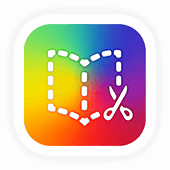
Get Book Creator for your school!
- Upgraded accounts for all your teachers
- Implementation plan to help with rollout
- PD support
- Analytics & admin dashboard
With 20 years of experience in education, Katie is passionate about creating inclusive and accessible classrooms for all students. She loves exploring new places, trying different foods, and connecting with fellow educators.



